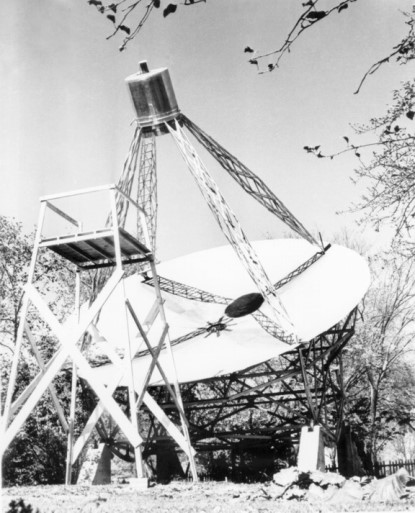Grote Reber and the Power of Amateurs
Olivia Wilkins
After the first detections of extraterrestrial radio waves by Karl Jansky were published in 1933, the implications of a new age in astronomy were quickly forgotten. Jansky's papers were published in radio engineering journals, either out of reach or out of the realm of interest of astronomers. Rather, it was an amateur astronomer who followed up on the discovery of cosmic radio waves.
Grote Reber, c. 1937 (image from Reber, Grote. "A Play Entitled the Beginning of Radio Astronomy." The Journal of the Royal Astronomical Society of Canada, 1988, 82(3), 93 via NRAO)
Grote Reber (1911-2002) was a professional engineer who sought to verify the existence of radio waves from extraterrestrial sources. Initially, he sought jobs at Bell Radio Labs (where Jansky made his discovery of extraterrestrial radiation) and astronomy observatories; however, the depression had taken ahold on the job market, rendering Reber's job hunt fruitless. A radio ham in his spare time, Reber build a steerable radio dish antenna, the first of its kind and a stark contrast to the antenna mechanism used by Jansky. Between 1935 and 1941, Reber developed and then used the 9.6-meter dish antenna to map radiation from the Milky Way from his backyard.
Grote Reber's first radio telescope in Wheaton, IL, c. 1937 (NRAO/AUI)
From his home in Wheaton, Illinois, Reber experimented with operating his receiver, which he built for $4,000, at different frequencies. He began at 3.3 GHz in 1937 and, after finding nothing, subsequently lowered his frequency range to 910 MHz (0.9 GHz) and ultimately 160 MHz. Finally, in April 1939, Reber had a detection at 160 MHz. These detections, which confirmed Jansky's discovery published just several years prior, were the result of long nights of observations, minimizing RFI from automobile sparkplugs.
Grote Reber (NRAO/AUI)
Between 1938 and 1943, Reber worked tirelessly to survey the radio sky. Publishing his results in both engineering and astronomy journals, he ignited the spark of radio astronomy as a major field of research in the years following World War II whereas Jansky's efforts faded into silence. Following up on Jansky's parabolic antenna design, research groups globally began improving the design of both antennas and receivers to begin detecting fainter radio waves more clearly.
Grote Reber with his donated Wheaton antenna at the National Radio Astronomy Observatory in Green Bank, WV, on October 16, 1958 (NRAO/AUI)
In the late 1950s, Reber donated his telescope to the NRAO in Green Bank, West Virginia. Reber supervised its assembly, and since then it has remained a historical monument. (Today, the telescope is red, white, and blue as it was painted for the U.S. bicentennial in the 1970s.) This telescope was not, however, Reber's only astronomical construction. in 1955, he traveled to Tasmania to conduct research at much lower frequencies than his previous work, whereas other scientists were turning to microwave frequencies (300 MHz to 300 GHz). In a pasture, Reber built an electronically steerable square-kilometer array which operated at 2 MHz. Using this telescope and another array in Canada, Reber discovered the absorption by ionized gas in the Milky Way.
While Reber's original mission in his radio astronomy pursuits were to confirm the propositions set forth by Karl Jansky, Reber accomplished something much more significant. His actions as an amateur influenced a revolution in astronomy research and yielded him several awards— the Henry Norris Russell Lectureship of the American Astronomical Society (1962), the Catherine Wolfe Bruce Gold Medal of the Astronomical Society of the Pacific (1962), and the Franklin Institute's Cresson Medal (1963). These awards, usually reserved for professional astronomers, are a testament to the importance of ingenuity and passion (rather than merely academic degrees held) in impacting the world.
References
- Ghigo, F. "Grote Reber and his Radio Telescope." National Radio Astronomy Observatory, 2004 (accessed 2016).
- Tyson, J. Anthony. "Grote Reber." Physics Today, August 2003, 63.
- Verschuur, Gerrit. The Invisible Universe: The Story of Radio Astronomy. Springer, 2007.
